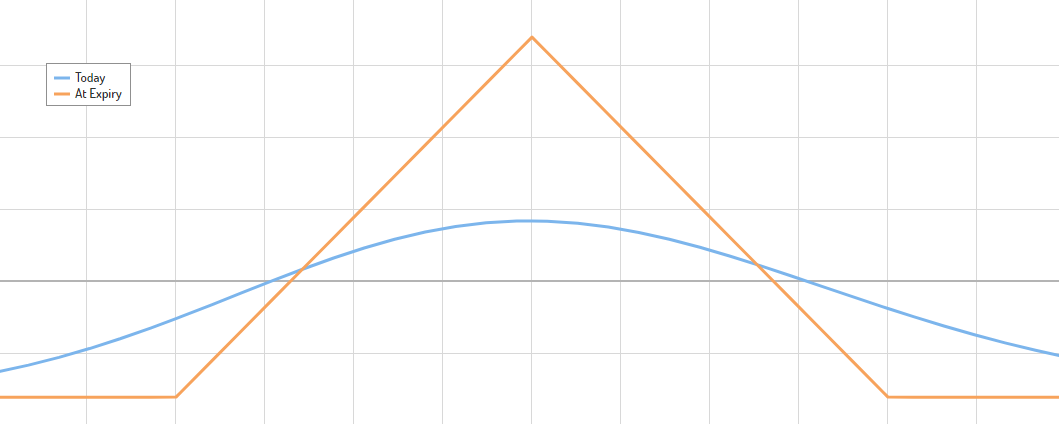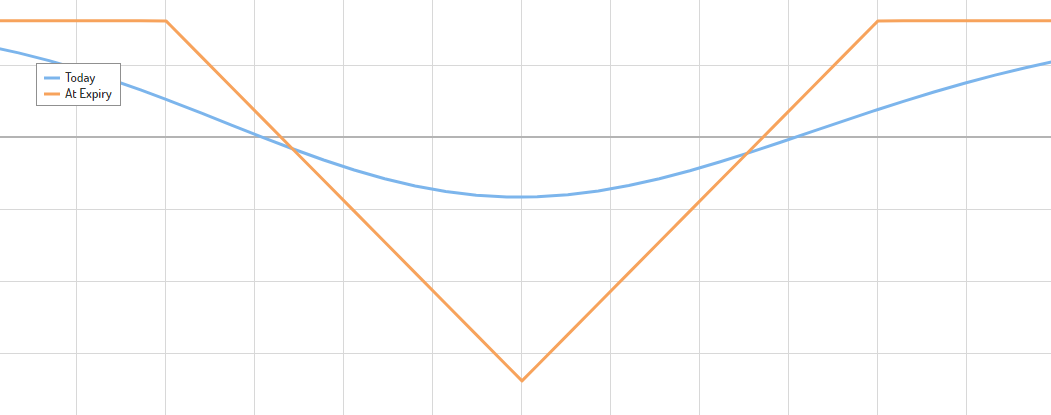Butterflies are neutral, cheap, low probability option strategies with relatively high potential payouts if used correctly. They have similar payoffs as calendar spreads but work quite differently. There are different ways to set up butterfly spreads. I will cover the most common ones here.
Video Breakdown:
Long Butterfly Option Strategy

Market Assumption:
When trading long butterfly spreads you should definitely have a neutral/range bound market outlook. You should expect that the price of the underlying asset only will move little. But different from Iron Condors, Strangles and Straddles butterfly spreads are much tighter and don’t allow the price to move that much. Therefore, long butterfly spreads are not suited for high probability trading. You can either set up a butterfly spread with calls or puts:
Setup:
- Buy 1 ITM Call
- Buy 1 OTM Call
- Sell 2 ATM Calls
or
- Buy 1 OTM Put
- Buy 1 ITM Put
- Sell 2 ATM Puts
This should result in a debit (Pay to open)
Profit and Loss:
As you can see on the payoff diagram a long butterfly spread is both a limited risk and limited profit strategy. The maximum profit is reached rather rarely because to achieve it the price of the underlying has to be exactly at the strike of the two short positions. This is also the reason why butterfly spreads are not very high probability strategies. Maximum drawdown, on the other hand, occurs when the price of the underlying asset is somewhere outside of the two long positions. The strikes of the two long positions are the break-even points (- commissions).
Maximum Profit: Strike of Short Option – Strike of Long Option (Width of Strikes) (*100) – Total Premium Paid – Commissions
Ex. 53 – 50 = 3 (3$ width of strikes) => 3$ *100 – 50$ (Total Premium Paid) – 5$ (Commission) = 245$ (max profit)
(a normal option contract controls 100 shares, therefore *100)
Maximum Loss: Total Premium Paid + Commissions
Ex. 50$ (Premium Paid) + 5$ (Commission) = 55$ (max loss)
Implied Volatility and Time Decay:
Time decay or the option Greek Theta works in favor of long butterfly spreads. Even though you have two long positions, the two short options still profit more from the time decay than the long positions lose from it. Time decay is highest in the last weeks before expiration.
Normally butterfly spreads profit from a drop in implied volatility (IV). This means that it is best to enter a butterfly spread in a high IV environment (IV rank over 50). But if the price moves a certain way after entry a butterfly spread can actually also profit from a rise in IV. So it depends on where the underlying price is. But I would always recommend that you enter this spread in times of high IV. But in general, IV won’t have a too large impact on butterfly spreads.
Short Butterfly Option Strategy
Next up, let’s take a look at the short butterfly options trading strategy.

Market Assumption:
If you choose to trade a short butterfly spread, you should expect a big move in the near future. The price won’t have to move as far as it would have to in some straddle strategies, but it still has to move a little. Such a small move isn’t unlikely and therefore short butterfly spreads can be used for high probability option strategies. If the underlying asset makes an even bigger move than you expect, you won’t make any more money, because of the limited profit potential of this strategy.
Setup:
- Sell 1 ITM Call
- Sell 1 OTM Call
- Buy 2 ATM Calls
or
- Sell 1 OTM Put
- Sell 1 ITM Put
- Buy 2 ATM Puts
This should result in a credit (You get paid to open)
Profit and Loss:
A short butterfly spread is a defined risk and defined profit strategy, just like you can see on the payoff diagram. The maximum profit is reached as soon as the price of the underlying asset moves a little further than one of the strikes of the short options. The maximum loss occurs when the price of the underlying is exactly at the strike of the two long positions. Max loss won’t occur too often because it only occurs on this very small spot.
Maximum Profit: Total Premium received – Commissions
Ex. 20$ Premium – 3$ = 17$ (max profit)
Maximum Loss: Strike of Short Option – Strike of Long Option (Width of Strikes) (*100) – Total Premium received + Commissions
Ex. (Strike 50 and 52) => 2$ Width * 100 – 20$ Premium + 3$ Commissions = 183$ (max loss)
(a normal option contract controls 100 shares, therefore *100)
Implied Volatility and Time Decay:
Time decay does not work in favor of a short butterfly spread. This is because it has a negative impact on the long options, which are the most valuable in this strategy. Time decay or the option Greek Theta will increase the closer you get to expiration.
A short butterfly spread usually profits from a rise in implied volatility (IV). Therefore, this strategy is best used in times of low IV (IV rank under 50). But just as said before, IV won’t have a too large impact on butterfly spreads.
Other Variations
There are a few other butterfly spread variations, like the iron butterfly option strategy. An iron butterfly is very similar compared to a normal butterfly spread. The payoff is exactly the same, but the setup is a little different. The setup reminds of a very narrow iron condor:
Setup
Long Iron Butterfly:
- Sell 1 OTM Call
- Buy 1 ATM Call
- Buy 1 ATM Put
- Sell 1 OTM Put
This should result in a debit (Pay to open)
Short Iron Butterfly:
- Buy 1 OTM Call
- Sell 1 ATM Call
- Sell 1 ATM Put
- Buy 1 OTM Put
This should result in a credit (You get paid to open)
Trader’s Note:
Iron butterflies work almost the same way as normal butterfly spreads. But a few aspects are a little different. For example, the max profit and max loss are calculated a little differently. Leave a comment if you want me to go more in-depth on iron butterflies.
Otherwise, there are even more variations of butterfly spreads, like the broken wing butterfly. Broken wing butterfly spreads work rather different than normal butterflies do and that’s why I covered them in THIS ARTICLE.

Louis,
I don’t know much about investing so I had not even heard of butterfly spreads! You certainly know your stuff! I am can see that your site and the programs you recommend would be a great education for anyone wanting to learn about the world of investing!
Thanks,
Jessica
Hey Jessica,
You are welcome. I am so glad that you are enjoying my site.
If you want to learn more about options and want to learn a consistent profitable option strategy you should check out my education:
https://tradeoptionswithme.com/options-trading-education
I offer three different courses for complete beginners up to advanced traders. I would recommend to start with the beginner course.
It looks like butterfly spreads should be used in markets where you don’t expect much movement. If a stock has been trading in a tight range for f a long time, and you expect it to continue, then I would think a butterfly spread might be the way to go. Is my thinking correct?
I don’t have a whole lot of experience with options, but I have used them a little in the past as a short-term (few months) strategy. I think anything over that would not be a fit for options. Just my thought…
Hey Andy,
Thanks for your comment. You definitely understood when someone would wanna use butterfly spreads.
I usually don’t trade options on a very long term basis either, but I am sure that there are some option traders who do and make some good profit.
If you want to learn more about options and want to learn a consistent profitable option strategy you may want to check out the education section here.
Hi Louis
I have noticed that in the video explanation you used any strike prices for the options used while in the script you identified the strike prices being ITM, OTM and ATM can you please explain if we need to stick to ITM, OTM and ATM or any strike price can work.
Another point is that in the video as well the script you used equidistant strike prices such as 105, 100, and 95 where the difference is constant i.e 105-100 = 5 and 100 – 95 =5 except in your last example in the video (your DIA trade) where the difference was not. Was that for the purpose of easy teaching or they should be equidistant.
thank you
Thanks for your comment.
Usually, butterflies are set up with ITM, ATM and OTM strikes. However, this does not mean that you can’t use any other strikes. You certainly can. This just depends on your directional assumption. Butterflies are most commonly used as a neutral strategy. If you use only ITM or OTM options, the butterfly will become much more directional. Furthermore, the strike selection will impact the max profit/loss and the probability of profit.
The strikes of standard butterflies are always equidistant. It doesn’t matter if the distance between them is 1, 2, 5, 10 or anything else. If the distance between the strikes varies, you get a so-called broken wing butterfly which is a different strategy.
In the DIA example in the video, I did use equidistant strike prices. But I probably didn’t present it clearly enough. For the DIA example, I chose the strike prices 211.5; 215.5 and 213.5.
212.5 was the price of DIA at the time of making this example. 212.5 was not a strike price for the example.
I hope I could clarify things. If you have any further questions or comments, don’t hesitate to let me know.
Hello Louis. How are you doing? many questions here …
Looking at the setups for the Straddle/ Strangles…
it looks like an Iron Condor is a risk-defined Strangle. Is this a fair statement?
then … is there a name for a risk-defined Straddle? i.e. what if you buy protection for each of the Straddle legs? is there a name for this?
i thought a risk-defined Staddle was an Iron Butterfly – but looking at the setups this appears to be wrong, since all of the butterfly legs are on the same side of the ledger (all Puts or all Calls) whereas the Straddle/ Strangle/ IC’s have legs on both sides of the ledger.
and what is the difference betw a Butterfly and Iron Butterfly?
Thx so much for your thoughts on these questions.
Hi Joel,
Thanks for your comment.
1. Calling an iron condor a risk defined strangle is appropriate.
2. A risk defined straddle is referred to as an iron butterfly.
3. A ‘normal’ butterfly is one where all options are either call or put options. An iron butterfly (or often just iron fly) is just an iron condor where the inner options are at the same strike (typically ATM). So an iron butterfly consists of both calls and puts.
I hope this answers your questions. But definitely let me know if you have any other questions or comments.